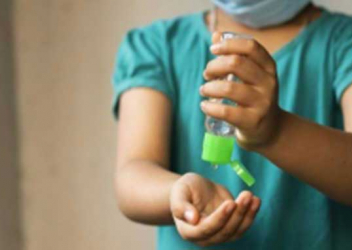Research In Action
Research In Action
Breadcrumb

The COVID-19 pandemic and new related behaviors have brought unique products, or unique quantities of normal products, into our homes. While performing injury surveillance in real time at the Poison Control Center at CHOP, we discovered that consumers, providers, and manufacturers may not realize that some of these products require thoughtful storage.
Calls to the Poison Control Center at CHOP in the early months of the COVID-19 pandemic showed an increasing number of exposures related to household cleaners and hand sanitizer products. Now that home COVID-19 test kits have become more widely available for purchase, we are receiving calls about accidental exposures to the extraction reagents (the small vials of liquids that come with test kits). From a five-month span (May to October 2021), we received 8 calls about exposures to COVID-19 home test reagents. Possibly in relation to an increased public health focus on home testing, 10 additional calls concerning exposures to the reagent chemicals were logged in less than two months (November 1 to December 22, 2021) alone. Most calls involved adults with accidental eye exposures. Four calls involved children ingesting the products.
The ingredients vary from product-to-product and may be hazardous. Many contain sodium azide, a preservative that can be poisonous and has been associated with concerning symptoms such as low blood pressure. We do not know yet what dosage of sodium azide causes these dangerous effects, making it difficult to assess risk. The good news is that cases of significant toxicity have not been reported due to these COVID-19 test reagents yet. This could in part be due to low concentrations of this chemical and the small (<1mL) sized containers. In other words, the dose makes the poison.
So far, the data indicate that exposures are often the result of “container confusion.” This happens when a chemical comes in similar packaging to products that someone uses a different way. For example, some of these kits store the extraction reagents in droppers that look very similar to eye drops (BinaxNOW, Ellume, SCoV-2 Ag Detect), and we encourage manufacturers of these products to reconsider how these chemicals are packaged to ensure safe use. As a newly introduced home product, families may not have considered how a COVID-19 test’s reagent container may present a poisoning or choking hazard to their children.
Tips to Share to Prevent Accidental Poisonings
It’s important to share the following tips with families to prevent container confusion and accidental poisonings in the home:
- Store all chemicals and medicines up, away, out of sight, and out of reach of young children.
- Even if you don’t have children at home, take care to store your household chemicals away from your personal care or food products.
- Children act fast: Even safe storage plans can fail if potentially hazardous products are not put back in their safe place when done using them.
- Carefully discard products like COVID-19 test kits when they have served their purpose.
- Do not open the test kit until needed and be sure to discard the components immediately.
It is easy to mistake the reagent for eye drops! Encourage families to call the Poison Control Center at CHOP -- 1 (800) 222-1222 -- for 24/7 guidance from nurses, pharmacists, and doctors with special training in toxicology, the study of poisoning.




